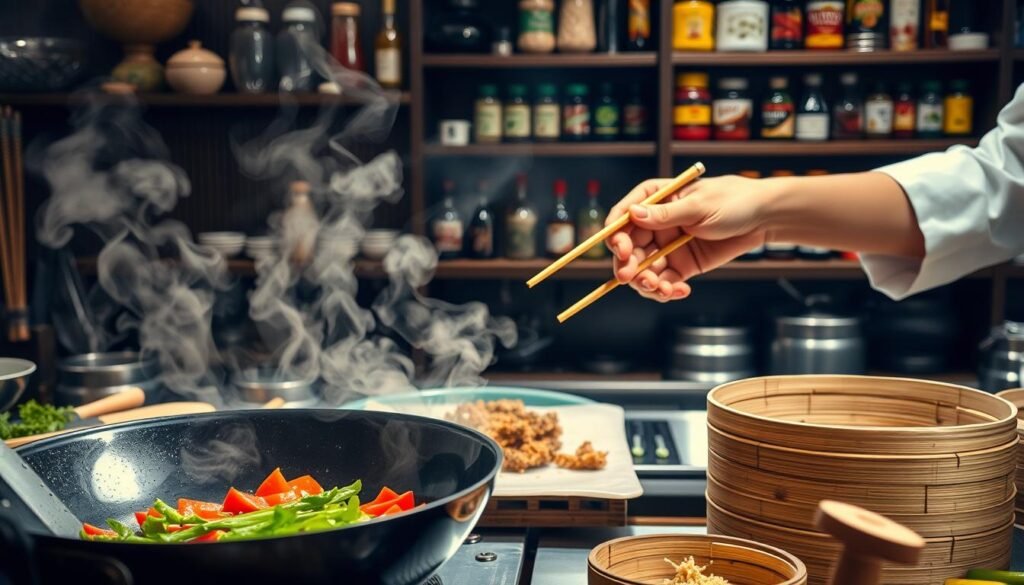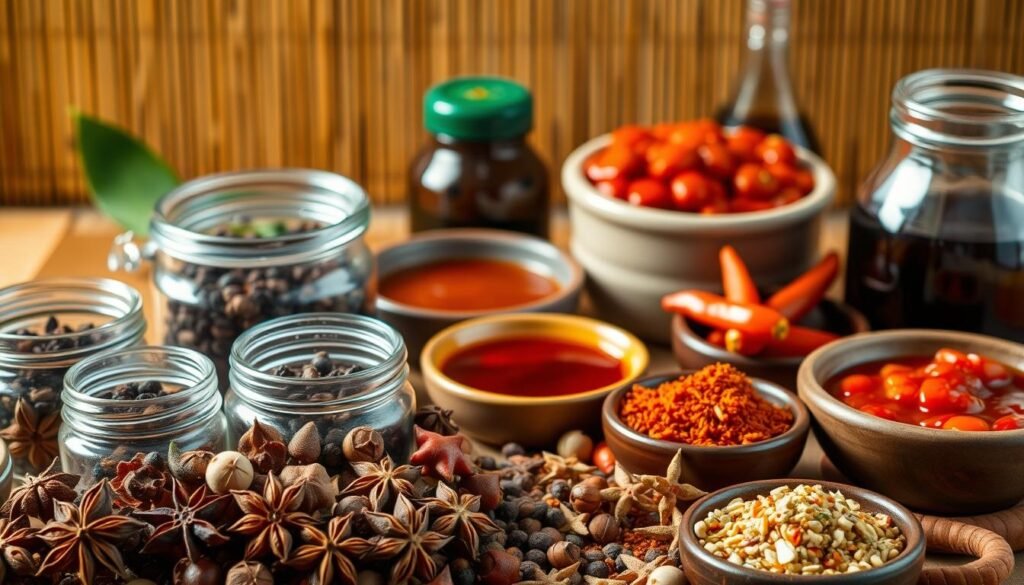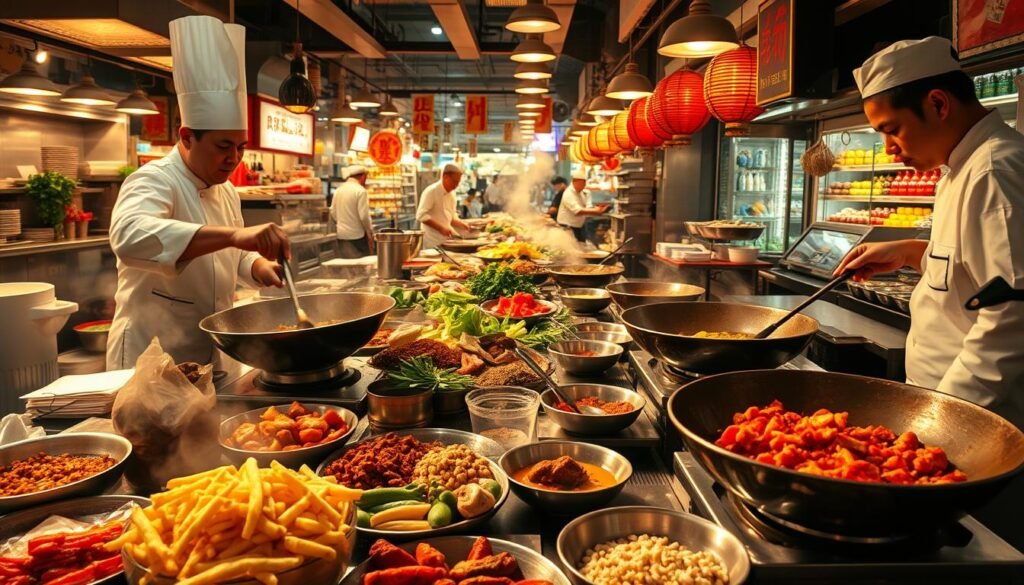Asian Cooking: Master the Art of Flavorful Meals

Have you ever walked past an Asian restaurant and wanted to make that food at home? You’re not alone! Asian cooking is more than food—it’s a joyful, flavorful experience. It’s about bringing the excitement of flavors into my kitchen. From the hot woks to the soft dumplings, exploring Asian food is like an adventure.
Imagine cooking a dish that tastes amazing and tells a story. Every ingredient and meal has its own history. For many, the journey into Asian cooking begins with curiosity. It ends with the joy of eating what we’ve made. Cooking at home has never been more fulfilling!
Key Takeaways
- Discover the vibrant world of Asian cooking.
- Learn to recreate authentic Asian meals at home.
- Experience the emotional and cultural richness of each dish.
- Unlock the joy and satisfaction of home cooking.
- Start your culinary journey with enthusiasm and curiosity.
Understanding the Basics of Asian Cuisine
Diving into Asian cuisine opens a world of flavors and skills! Let’s explore the basics, like important ingredients and cooking ways.
Key Ingredients in Asian Cooking
Chinese food often uses soy sauce, a flavorful staple. Made from fermented soybeans, wheat, salt, and water, it adds umami. There are two kinds: light soy sauce is saltier, and dark soy sauce has a deeper taste. Both are key for marinades, stir-fries, and sauces.
Ginger and garlic are essential in Asian recipes. Ginger adds zest, while garlic brings a savory taste. They are common in Japanese and Korean dishes, used to enhance stir-fries to soups.
Rice is crucial in Asian food, especially in southern China. Different types of rice match various dishes. Using these ingredients makes meals authentic and tasty.
Common Cooking Techniques
Steaming and stir-frying are basic in Asian cuisine. Steaming keeps food’s flavors and textures. It’s great for dumplings and dim sum. Japanese dishes often use it, and a wok suits steaming well in Chinese cooking.
Stir-frying cooks food fast with high heat and oil in a wok. It keeps ingredients’ color, texture, and nutrients. This makes dishes like veggie stir-fry or beef delicious and healthy.
Learning about these ingredients and cooking ways helps make amazing Asian dishes. They’ll surely wow your family and friends!
Regional Variations of Asian Cooking
Asian cooking is a mosaic of flavors, techniques, and traditions. It creates a vast culinary tapestry. You might start with the robust curries of India or the delicate sushi of Japan. The diverse options are indeed thrilling. Let’s explore the unique differences in these cuisines.
East Asian Flavors: China, Japan, Korea
East Asian food balances taste with beauty in presentation. Imagine China’s bold flavors, like savory Peking duck and rich soy sauce. Japan values simplicity, seen in sushi, light tempura, and ramen. Korea brings spice with kimchi, bibimbap, and their Korean BBQ. Each offers unique tastes that will amaze you!
Southeast Asian Delights: Thailand, Vietnam, Indonesia
Welcome to the world of Thai, Vietnamese, and Indonesian foods – vibrant and aromatic! Thai food mixes sweet, sour, salty, and spicy perfectly. Dishes like Tom Yum soup and Pad Thai showcase this balance. Vietnamese cuisine uses fresh ingredients and herbs in dishes like the iconic Pho. Indonesian meals, such as spicy rendang and nasi goreng, reflect a rich cultural heritage.

| Dish | Country | Main Ingredients |
|---|---|---|
| Pad Thai | Thailand | Rice noodles, shrimp, peanuts, bean sprouts |
| Pho | Vietnam | Rice noodles, beef, herbs, lime |
| Rendang | Indonesia | Beef, coconut milk, lemongrass, spices |
South Asian Influences: India, Pakistan, Bangladesh
South Asian food celebrates spices and vibrant flavors. India’s dishes, like butter chicken and biryani, show off complex spice layers. Pakistan offers juicy kebabs and rich biryanis. Bangladesh has bold fish curry and fragrant rice dishes. While these countries share a love for spices, each brings its own twist, making their foods unique and mouthwatering.
Essential Equipment for Asian Cooking
Before you start cooking Asian dishes, you need the right tools. The right tools make cooking easier and more fun! Let’s look at what you need for your kitchen.

Woks and Stir-Fries
A good wok is key for stir-frying. Carbon steel woks heat up fast and adjust to temperature changes well. This is important for getting the wok hei taste. The Yosukata Carbon Steel Wok Pan is great for this. It heats quickly and works on Western stoves. The wooden handle is comfy, but may not suit everyone. You can buy a lid for it separately.
| Feature | Yosukata Carbon Steel Wok Pan |
|---|---|
| Material | Carbon Steel |
| Design | Flat-bottom |
| Handle | Wooden |
| Special Needs | No lid (sold separately) |
Rice Cookers and Steamers
Perfect rice is important for Asian meals. The Instant Pot Duo Plus is very versatile. It’s a pressure cooker, slow cooker, rice cooker, and more. It’s easy to use and perfect for big families.
Knives and Cutting Boards
Cutting well is key in Asian cooking. A sharp knife makes sure slices are even. This means food cooks right and looks good. Investing in a great chef’s knife can make a big difference. Brands like Wüsthof and Shun are known for quality and lasting long.
With these tools, learning Asian cooking is easier and more fun. Are you ready to start cooking?
Practical Tips for Cooking Asian Dishes
Want to cook amazing Asian meals? I’ve got some handy tips for you. These will help your dishes taste authentic. They work whether you’re a beginner or a pro.
Balancing Flavors: Sweet, Sour, Spicy, Salty
Authentic Asian meals are all about flavor harmony. Ever wonder why they taste so good? It’s about mixing sweet, sour, spicy, and salty. Adding tamarind paste and a bit of honey adds sweetness. Try fish sauce for umami. Mastering these will make your dishes stand out.
Preparing Fresh Ingredients
Using fresh ingredients is key. Authentic dishes need fresh veggies, herbs, and proteins. Prep everything before cooking. This makes cooking easier and your dish tastier. Imagine fresh Thai basil in your curry. It’s small steps like these that make a big difference.

Mastering Rice and Noodles
Dig into the heart of Asian Cooking by learning about rice and noodles. These key ingredients make many dishes tasty. They offer different textures and tastes, making your cooking better! Whether you like sticky rice, basmati, or soba noodles, knowing these basics is crucial.

Types of Rice Used in Asian Dishes
Rice is crucial in Asian Cooking, as it’s the base of many meals. Jasmine rice adds a sweet smell, perfect for Thai food, while short-grain rice is great for sushi. Basmati rice, often used in Indian meals, is fluffy and smells wonderful. Each rice type has its own special texture and flavor, making dishes special.
Making Perfect Noodles
Noodles are key in Asian Cooking too, offering many meal options. Soba noodles, from buckwheat, are loved in Japanese meals for their nutty taste. Rice noodles are important in Thai and Vietnamese foods because they’re light and soft. Cooking noodles right is important – follow the directions and rinse them in cold water when done. This keeps them soft but not mushy, perfect for absorbing sauces or broths!
Spices and Sauces: The Heart of Flavor
Exploring Asian cuisine shows us spices and sauces are key. They infuse meals with deep, aromatic flavors. These tastes take us on a journey to places like Bangkok’s lively markets or Kyoto’s calm gardens.
Common Spices in Asian Cuisine
We begin with Asian spices, true flavor powerhouses. There’s cinnamon’s warmth in Chinese five-spice, for instance. And Sichuan pepper’s bold kick.
Star anise adds a licorice twist to dishes like pho. Turmeric brings a golden color and earthy taste to curries.
Essential Sauces You Need
Now, onto Asian sauces, crucial for authentic flavors. Soy sauce adds savory notes to meals. Meanwhile, fish sauce brings a distinct umami.
Oyster sauce makes vegetables taste like they’re from a fancy restaurant. Hoisin sauce is great for meat glazes or as a dip.

Popular Asian Cooking Techniques
Exploring Asian culinary techniques will take your cooking to the next level! Stir-frying and steaming are top methods. They bring out bold flavors and are good for your health. Let’s learn how to do them.
Stir-Frying: Quick and Flavorful
Stir-frying is a big deal in many Asian foods. It cooks food fast with high heat. This creates yummy dishes in no time! Picture veggies, lean meats, or tofu sizzling in a wok. Yum, right?
Stir-frying keeps your food looking and tasting fresh. It’s also a healthy way to cook. So, turn up the heat and make your kitchen smell amazing!

Steaming: Preserving Nutrients
Steaming is key in Asian culinary techniques. It’s simple and healthy. Foods like fish, veggies, and dumplings become tender and tasty. This method keeps their goodness and flavor.
It’s great for healthy cooking because you don’t need oil. Want to taste your food’s true flavor? Try steaming. You’ll love the results!
Vegetarian and Vegan Options in Asian Cooking
Diving into Vegan Asian cooking shows us many exciting dishes. They’re full of bright flavors! Think of tofu to tempeh, Asian dishes have a lot of vegetarian recipes. Let’s look into these tasty options together!

Plant-Based Proteins
In Vegan Asian cooking, plant-based proteins are key. Tofu, from soybeans, is used a lot for its flavor-soaking ability. Then there’s tempeh, with a nutty taste and firm texture. It’s great in stir-fries and soups. And don’t skip edamame, the young soybeans. They’re great as a snack or in salads!
Preparing Flavorful Vegetable Dishes
Making tasty veggie dishes is easy with vegetarian recipes from Asian cooking. Imagine colorful stir-fries with broccoli, bell peppers, and snap peas. They’re mixed in a tasty sauce. Or a cozy miso soup filled with mushrooms, seaweed, and tofu.
Steaming veggies keeps their nutrients and colors. It also keeps their crunch and taste. Whether it’s a spicy Thai curry or a gentle Japanese bento, your vegetable dishes will be the star!
Exploring Asian Desserts and Sweets
Exploring Asian desserts excites me with their sweet variety! Traditional treats and modern spins dazzle the taste buds.
Traditional Asian Sweets
Mochi and red bean cakes are great for sweet cravings. Mochi is chewy, filled with red bean paste, strawberries, or ice cream. Red bean cakes are sweet and textured, a timeless snack.
Modern Twists on Classic Desserts
Kitchens today give classic desserts a fresh twist. Think of matcha mochi or mango pudding with coconut cream. These modern treats keep traditional vibes but add fun twists.
Asian desserts make meals special with their unique tastes and textures. Excited to try making these sweets?
Health Benefits of Asian Cooking
Asian cooking is great for tasty meals and your health. It has many health benefits because it uses fresh, good-for-you ingredients. Let’s explore why Asian cooking is so good for you.

Nutrient-Dense Ingredients
Asian cooking is known for its healthy ingredients. It uses bright veggies, lean meats, and good fats. Ingredients like ginger and miso add flavor and are good for you. Eating these foods means you’re getting lots of nutrients with every bite.
Mindful Eating Practices
Mindful eating is a big part of Asian cuisine. It’s about enjoying each bite slowly. This helps you digest better and feel full faster. Asian meals are all about balance, mixing flavors and textures. This way, you don’t eat too much and your body feels good.
Resources for Aspiring Asian Cooks
If you want to get better at Asian cooking, you’re in luck! There are many books, sites, and classes online that can help. They make learning the secrets of Asian cooking easy and fun, right at home.
Recommended Cookbooks and Websites
Start by exploring top cookbooks like “The Food of Thailand” by David Thompson. Or try “Every Grain of Rice: Simple Chinese Home Cooking” by Fuchsia Dunlop. These books are full of recipes and tips that can turn your kitchen into an Asian cooking paradise. For online resources, check out Serious Eats and Epicurious. They have lots of Asian cooking guides and advice.
Online Cooking Classes and Tutorials
How about joining online classes on Asian cooking? On MasterClass, chefs like Gordon Ramsay teach Chinese cooking. Skillshare also offers many cooking tutorials. These sites make learning new cooking skills fun. You can explore new ingredients and improve your cooking, all from home.